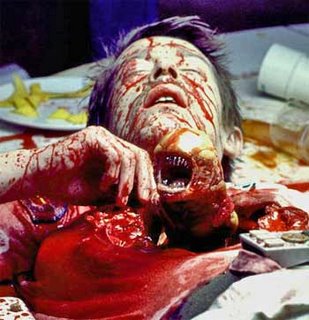There are a surprising number of end of the world scenarios. My favorites, in order, are:
General existence failure: based off a very loos interpretation of several principles and observations in quantum mechanics. The assumption is that a given quanta of matter does not explicitly exist at a given time and place, but rather has the simple potential to exist. Presumably, said quanta pop into and out of existence regularly (and yet always maintain the balance of energy and matter in the universe), but it happens at such a scale that it is inconsequential. If, for whatever reason you choose, the entire mass that is the earth (or even universe as the difference in scale has little real impact on the probability as far as people are concerned) should suddenly decide to shift about at the same (or nearly the same) moment, the world would almost certainly probably (maybe) end. The best part is, you don't need to do anything save sit around and wait for the impossibly implausible to happen.
Ice-9 type transition: Based upon the book cat's cradle. The theory goes something like this: water, when a solid, forms a crystal. If you look at another common crystalline structure, sugar, you'll find that it takes a number of different forms. The resulting product (say rock candy or perhaps fudge) has properties that result from this very structure. One of these properties is melting point. If you have ever tried making candy (especially chocolate based) you'll find that this property is terribly important. If you reach the wrong crystalline state when making fudge, you may end up with something with a liquid consistency at room temperature (I believe very technically, the caramel stage is considered an amorphous material), or perhaps something that is rock hard at the same. Also, as a crystal begins to form, other molecules will tend to arrange themselves upon said crystal in the same structure. To go back to the candy analogy, if one starts forming hard sugar crystals during the process of making fudge (the process involves reducing a solution of various sugars and water with heat, and crystal formation will occur if one is not careful), as the fudge sets these crystals will expand producing a grainy texture. If one could devise a crystalline structure of water that achieved a melting point above the maximum temperature of of the planet (on average at least), and introduced said crystal into a body of water (say the ocean) then water molecules would eventually expand said crystal until much of the water in the world was locked inside this new type of ice. Presumably, such a transition would have a devastating impact on the world as a whole.
The big crumble: In case you were not aware, there are only a few known constants in the world of physics, and the world as we know it could not possibly exist if these numbers changed even slightly. There are only a few (I forget the exact number but it's somewhere around 25), but they include the mass of the proton, The strong nuclear force, the gravitational constant and so forth. If the gravitational constant increased for example, stars would instantly collapse into black holes, if it were reduced they would explode apart. If the strong nuclear force increased, stars would exhaust their fuel in moments (and likely, explode). You could go on like this at length. Suffice it to say that everything you know about the world, about the universe, relies on these numbers being exactly what they are. While it is generally assumed that these are indeed constant, there has been recent evidence indicating that, at the furthest reaches of the stars, some of these values are slipping ever so slightly. Not that this should cause a panic or anything. It could be the result if inaccurate testing apparatus, misinterpretation of data, or even that our own interpretation of what these numbers represent and what they govern is flawed.


